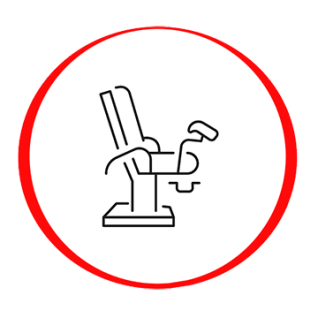Sampling 6.00€

10 STDs (sexually transmitted diseases) testing panel
95.00€
The validity period for online orders: 3 months from the date of purchase.
Chlamydia trachomatis is one of the most common sexually transmitted infection-causing agents. Chlamydia infection often can be asymptomatic, especially in its early stages. It affects both men and women and can damage various body sites, including the genitals, rectum, and throat. Without symptoms, untreated chlamydia can lead to serious complications, such as infertility, chronic infections, and Reiter's syndrome. Initial symptoms appear 1-3 weeks after infection. Women may experience abnormal vaginal discharge, pain during urination, bleeding between periods, and pain during intercourse. Men may experience abnormal penile discharge, pain during urination, and testicular pain and swelling. Regular check-ups and immediate treatment are crucial to prevent complications and reduce the risk of infecting others.
Neisseria gonorrhoeae - gonorrhea is a widespread infection transmitted through oral, vaginal, or anal sex. Symptoms usually appear 1–14 days after sexual contact with an infected person. Many women do not exhibit symptoms, but may experience bleeding between periods or during intercourse, and pain or burning during urination. Undetected, untreated, or improperly treated infection can spread to the upper reproductive tract, developing into complicated gonococcal infection, causing pelvic inflammatory disease, ectopic pregnancy, infertility in women, and penis edema, epididymitis in men.
Mycoplasma genitalium - this bacterium most commonly infects the urethra, cervix, and its infection can be asymptomatic. Untreated infection in some cases may lead to more serious complications such as urethritis or cervicitis, infertility.
Mycoplasma hominis, Ureaplasma urealyticum, Ureaplasma parvum - these bacteria may naturally be found in the genital tract (uterus, ovaries, prostate gland), often causing no symptoms or diseases. In certain cases, they may cause infections and symptoms, which vary depending on which part of the reproductive organs is affected pathologically.
Trichomonas vaginalis - the most common non-viral sexually transmitted pathogen in the world. T. vaginalis may cause abnormal vaginal discharge (trichomoniasis) in women and accounts for 10~12% of all non-gonococcal urethritis cases in men. The infection can be asymptomatic in at least 50% of women and 70~80% of men.
Herpes simplex 1/2 infections are transmitted through contact with HSV herpes sores, mucous membranes, genital secretions, or oral secretions. HSV-1 and HSV-2 may be released from normal-appearing oral or genital mucosa or skin. Typically, a person can only contract HSV-2 during genital contact with someone with an HSV-2 infection. Oral-genital contact from a person with oral HSV-1 can cause genital HSV-1 infection. Transmission often occurs through contact with an infected partner who has no visible lesions and may not be aware they are infected. Most individuals with HSV are asymptomatic or have very mild symptoms that go unnoticed or are mistaken for another skin condition. When symptoms occur, herpes lesions usually appear as one or more blisters on or around the genitals, rectum, or mouth. The average incubation period for a first herpes infection is 2 to 12 days after exposure. The blisters break and leave painful ulcers that may take two to four weeks to heal. The appearance of these symptoms is referred to as the first herpes "outbreak" or episode. Clinical manifestations of genital herpes differ between the first and recurrent (i.e., later) outbreaks. The first herpes outbreak is often associated with a longer healing period, increased virus shedding (thus increasing the likelihood of HSV transmission), and systemic symptoms, including fever, body aches, swollen lymph nodes, or headache.
Treponema pallidum is the bacterium that causes syphilis, a chronic systemic infection that can progress through four stages. Primary symptoms appear 10 - 90 days after infection, usually within 3 weeks (21 days). The main symptom is a painless sore that appears at the infection site. The sore may be hard to notice and often disappears within 3–6 weeks even without treatment, but may periodically recur. Early diagnosis and treatment are essential to prevent the progression of the infection.
Chlamydia trachomatis LGV - one of the diseases caused by the chlamydia bacterium is lymphogranuloma venereum (LGV). LGV is a sexually transmitted infection caused by specific Chlamydia trachomatis serovars (L1, L2, L3). The primary mode of transmission is through vaginal, anal, and oral sex. The primary symptom is small, painless blisters or sores on the genital or rectal area, which are often unnoticed. Symptoms appear 3-30 days after infection. If untreated, chronic inflammation, lymph node, rectal damage, and reproductive system problems may develop.

Reference: 19060
95.00€






